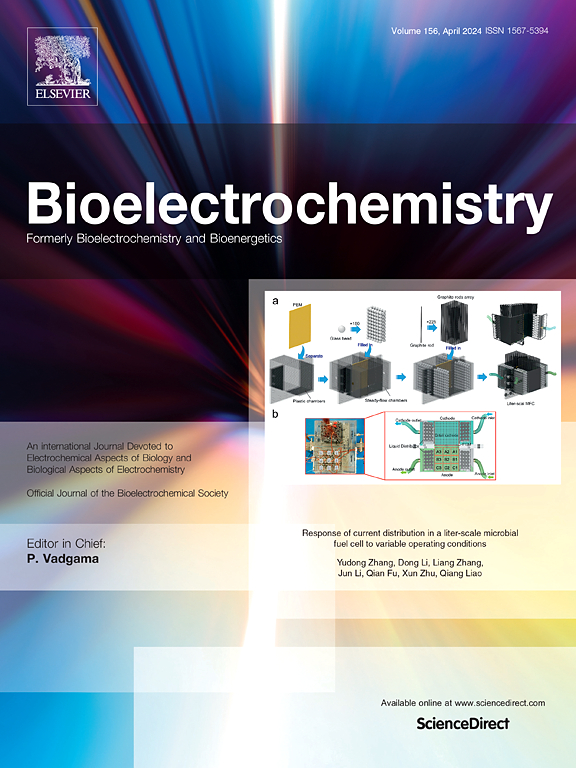TdT 与 Cas14a 结合用于鼻咽癌外泌体的电化学生物传感。
IF 4.8
2区 化学
Q1 BIOCHEMISTRY & MOLECULAR BIOLOGY
引用次数: 0
摘要
在这项工作中,基于末端脱氧核苷酸转移酶(TdT)、CRISPR/Cas14a和磁性纳米颗粒(MNPs)的微妙组合,开发了用于检测鼻咽癌(NPC)衍生外泌体的电化学生物传感器。由于以下因素的协同作用:利用TdT对3-羧基端单链DNA (ssDNA)的强大延伸能力、CRISPR/Cas14a与靶DNA结合特异性激活的卓越反式切割能力以及MNPs的优异分离能力,所开发的电化学生物传感器对npc衍生外泌体的检测具有很高的灵敏度,线性范围为6.0 × 102 ~ 1.0 × 105颗粒/mL,检测限低至80颗粒/mL。此外,该电化学生物传感器成功地区分了鼻咽癌患者和健康人的外泌体。这种电化学生物传感器为鼻咽癌的早期诊断开辟了一条新的途径。缩写:NPC,鼻咽癌;CRISPR/Cas,聚集规则间隔短回文重复序列/CRISPR相关蛋白系统;PAMs, Protospacer邻近图案;滚动圈放大;CHA,催化发夹组件;LAMP,环介导等温扩增;末端脱氧核苷酸转移酶;SgRNA,单导RNA。本文章由计算机程序翻译,如有差异,请以英文原文为准。
TdT combined with Cas14a for the electrochemical biosensing of NPC-derived exosomes
In this work, the electrochemical biosensor based on the subtle combination of terminal deoxynucleotidyl transferase (TdT), CRISPR/Cas14a, and magnetic nanoparticles (MNPs) was developed for the detection of nasopharyngeal carcinoma (NPC)-derived exosomes. Due to the synergistic effect of the following factors: the powerful elongation capacity of TdT for single-stranded DNA (ssDNA) with 3-hydroxy terminus, the outstanding trans-cleavage ability of CRISPR/Cas14a specifcally activated by the crRNA binding to target DNA, and the excellent separation ability of MNPs, the developed electrochemical biosensor exhibited high sensitivity for the detection of NPC-derived exosome, with a linear range from 6.0 × 102 ∼ 1.0 × 105 particles/mL and a limit of detection as lown as 80 particles/mL. In addition, this electrochemical biosensor successfully distinguished exosomes from NPC patients and healthy individuals. This electrochemical biosensor opens up a new pathway for the early diagnosis of NPC.
Abbreviations: NPC, Nasopharyngeal carcinoma; CRISPR/Cas, Clustered regularly interspaced short palindromic repeats/CRISPR-associated proteins system; PAMs, Protospacer adjacent motifs; RCA, Rolling circle amplification; CHA, Catalytic hairpin assembly; LAMP, Loop-mediated isothermal amplification; TdT, Terminal deoxynucleotidyl transferase; SgRNA, Single guide RNA.
求助全文
通过发布文献求助,成功后即可免费获取论文全文。
去求助
来源期刊

Bioelectrochemistry
生物-电化学
CiteScore
9.10
自引率
6.00%
发文量
238
审稿时长
38 days
期刊介绍:
An International Journal Devoted to Electrochemical Aspects of Biology and Biological Aspects of Electrochemistry
Bioelectrochemistry is an international journal devoted to electrochemical principles in biology and biological aspects of electrochemistry. It publishes experimental and theoretical papers dealing with the electrochemical aspects of:
• Electrified interfaces (electric double layers, adsorption, electron transfer, protein electrochemistry, basic principles of biosensors, biosensor interfaces and bio-nanosensor design and construction.
• Electric and magnetic field effects (field-dependent processes, field interactions with molecules, intramolecular field effects, sensory systems for electric and magnetic fields, molecular and cellular mechanisms)
• Bioenergetics and signal transduction (energy conversion, photosynthetic and visual membranes)
• Biomembranes and model membranes (thermodynamics and mechanics, membrane transport, electroporation, fusion and insertion)
• Electrochemical applications in medicine and biotechnology (drug delivery and gene transfer to cells and tissues, iontophoresis, skin electroporation, injury and repair).
• Organization and use of arrays in-vitro and in-vivo, including as part of feedback control.
• Electrochemical interrogation of biofilms as generated by microorganisms and tissue reaction associated with medical implants.
 求助内容:
求助内容: 应助结果提醒方式:
应助结果提醒方式:


